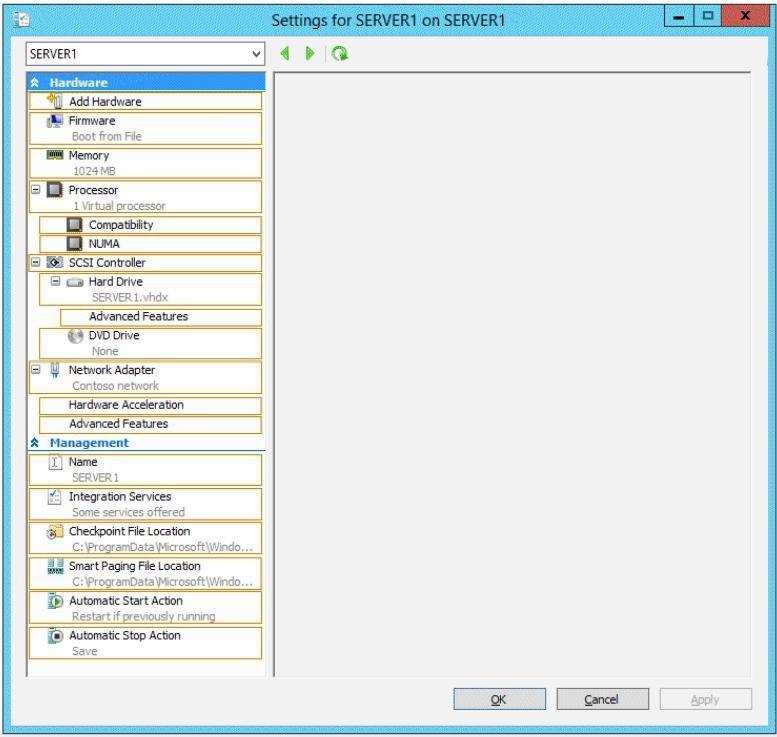Which two objects should you configure?
You have a Hyper-V host named Hyperv1 that runs Windows Server 2012 R2.Hyperv1 hosts a virtual machine named Server1.Server1 uses a disk named
Server1.vhdx that is stored locally on Hyperv1.
You stop Server1, and then you move Server1.vhdx to an iSCSI target that is located on another server.
You need to configure Server1 to meet the following requirements:
Ensure that Server1 can start by using Server1.vhdx.
Prevent Server1.vhdx from consuming more than 500 IOPS on the iSCSI target.
Which two objects should you configure?
To answer, select the appropriate two objects in the answer area.
Hot Area:
You need to move all of the applications and the servic…
CORRECTED (Previously B)Your network contains two servers named Server1 and Server2 that run Windows
Server 2008 R2. Server1 and Server2 are nodes in a failover cluster named Cluster1.
The network contains two servers named Server3 and Server4 that run Windows Server 2012 R2. Server3 and
Server4 are nodes in a failover cluster named Cluster2.
You need to move all of the applications and the services from Cluster1 to Cluster2.
What should you do first from Failover Cluster Manager?
What should you create on Server1?
You need to ensure that the virtual machines on Server1…
Your network contains an Active Directory domain named contoso.com. The domain contains two servers
named Server1 and Server2 that run Windows Server 2012 R2. Server1 is a file server that has the Hyper-V
server role installed.
Server1 hosts several virtual machines. The virtual machine configuration files are stored on drive D and the
VHD files are stored on drive E.
You plan to replace drive E with a larger volume.
You need to ensure that the virtual machines on Server1 remain available while drive E is being replaced.
What should you do?
You need to change the DNS server used by IPv6
You have a server that runs a Server Core installation of Windows Server 2012 R2.
You need to change the DNS server used by IPv6.
What should you do?
which method should you move VM1?
You have a datacenter that contains six servers. Each server has the Hyper-V server role installed and runs
Windows Server 2012 R2. The servers are configured as shown in the following table.
Host4 and Host5 are part of a cluster named Cluster1. Cluster1 hosts a virtual machine named VM1.
You need to move VM1 to another Hyper-V host. The solution must minimize the downtime of VM1.
To which server and by which method should you move VM1?
Which virtual machine setting should you configure?
Your network contains an Active Directory domain named contoso.com. The domain contains a server named Server1 that runs Windows Server 2012 R2.Server1
has the Hyper-V server role installed. The domain contains a virtual machine named VM1.
A developer wants to attach a debugger to VM1.
You need to ensure that the developer can connect to VM1 by using a named pipe.
Which virtual machine setting should you configure?
You need to verify whether the replica of VM5 on Server…
Your network contains two servers named Server1 and Server2 that run Windows Server 2012 R2. Server1
and Server2 have the Hyper-V server role installed. Server1 and Server2 are configured as Hyper-V replicas of
each other.
Server2 hosts a virtual machine named VM5. VM5 is replicated to Server1.
You need to verify whether the replica of VM5 on Server1 is functional. The solution must ensure that VM5
remains accessible to clients.
What should you do from Hyper-V Manager?
You need to ensure that you can create a 3-TB volume on…
You have a server named Server1 that runs Windows Server 2012 R2.You add a 4-TB disk named Disk 5 to Server1.
You need to ensure that you can create a 3-TB volume on Disk 5.
What should you do?
You need to ensure that multiple backups of Server1 are…
Your network contains two servers that run Windows Server 2012 R2 named Server1 and Server2. Both
servers have the File Server role service installed.
On Server2, you create a share named Backups.
From Windows Server Backup on Server1, you schedule a full backup to run every night. You set the backup
destination to \\\\Server2 \\Backups.
After several weeks, you discover that \\\\Server2\\Backups only contains the last backup that completed on
Server1.
You need to ensure that multiple backups of Server1 are maintained.
What should you do?




